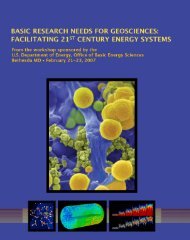Materials Science and Engineering for Clean Biomass Cookstoves
Materials Science and Engineering for Clean Biomass Cookstoves
Materials Science and Engineering for Clean Biomass Cookstoves
Create successful ePaper yourself
Turn your PDF publications into a flip-book with our unique Google optimized e-Paper software.
<strong>Materials</strong> <strong>Science</strong> <strong>and</strong> <strong>Engineering</strong><strong>for</strong> <strong>Clean</strong> <strong>Biomass</strong> <strong>Cookstoves</strong>Ömer DoğanDon Ferguson <strong>and</strong> James BennettDOE <strong>Biomass</strong> <strong>Cookstoves</strong> Technical Meeting – January 11-12, 2011 – Alex<strong>and</strong>ria, VA.
<strong>Materials</strong>• <strong>Materials</strong> are enabling technology <strong>for</strong> cookstoves.• To make clean, efficient, af<strong>for</strong>dable, widely-used <strong>and</strong>durable biomass cooking stove, one has to haveappropriate materials <strong>for</strong> the cookstovecomponents.2
<strong>Clean</strong> Cookstove <strong>Materials</strong>• Structural materials– Combustion chamber– Insulation <strong>and</strong> envelope– Accessories (grate, skirt, etc.)• Functional materials– Thermoelectric generator– Heat conducting probe– Heat sinkN. MacCarty, J.Cedar,Proceedings of ETHOS 20103
Current Examples of Combustion Chamber<strong>Materials</strong>• Refractory ceramics– Prefired refractory shape (refractory fired to final“brick”)– Plastic refractory (refractory shaped to need)– Castable refractory (shape cast)– Ceramic fiber (potential backup material)– Powdered refractory filler• Metallic materials– Steel (mild steel, Cr steel, stainless steel)– Cast iron4
<strong>Materials</strong> Selection Criteria <strong>for</strong> CombustionChamber• Is the material low cost?• Can the material be produced locally (in thecountry)?• What type of biomass fuel will the stove use?• Will the stove combust or gasify?• What is the shape of the temperature profile in thestove?• Is heat insulation a requirement?• What is the minimum life expectancy?5
FUELTapack6Sjoerd Nienhuys, Improved Cooking Stove –Metal One Pot, August 2010Treshkin
Fuel Types <strong>and</strong> Potential Flame Temperatures• In the absence of moisture <strong>and</strong> assuming adiabatic(no heat loss) conditions:Mass FractionFuels C H O N S AshFlame Temperature(K)Bituminous Coal 75.5 5 4.9 1.2 3.1 10.3 2445Ag Waste (CornStover) 47.04 5.47 0.68 41.1 0.06 5.65 2070Wood (Pine) 50.26 5.98 0.03 42.14 0.01 1.58 2253Switchgrass 47.33 5.61 0.67 41.05 0.07 5.27 2150Charcoal 92.04 2.45 2.96 0.53 1 1.02 1300• Addition of moisture <strong>and</strong> heat loss will reduce flame temperatures7
Emissions from <strong>Biomass</strong> Fuel Flames• Carbon Monoxide• PM: Volatile Organic Compounds (VOC), Poly-Aromatic Hydrocarbons (PAH)• Sulfur Dioxide, Hydrogen Sulfide, Aldehydes, Etc.• Most of these can be reduced through improvedcombustion– Longer residence times– Increased temperatures8
Select <strong>Biomass</strong> Ash Chemistry, Quantity, <strong>and</strong>Melting TemperatureProperty (Wt %)MaterialRiceStrawWheatStrawSwitchGrassSugar CaneTrashDouglas FirWood% Cl (dry wt biomass) 0.7 2.0 0.1 0.2 0.01% Ash (dry wt biomass) 19.5 13.0 9.0 5.0 0.5Oxide (in Ash) - Al 2O 31.4 2.5 4.5 NL 2.8CaO 1.6 4.7 5.6 13.1 37.1Fe 2O 30.7 1.0 2.0 1.7 4.2K 2O 11.3 18.3 11.6 13.4 17.0MgO 1.9 2.5 3.0 4.3 5.9Na 2O 1.9 10.5 0.6 0.3 3.2P 2O 52.7 1.5 4.5 2.3 1.9SiO 274.3 35.8 65.2 57.4 12.3TiO 20.02 0.2 0.2 NL 0.1SO 30.8 5.5 0.4 7.3 11.2Unknown 3.4 17.6 2.3 0.3 4.4Melting Temperature ( o C) 1494 1294 1468 1300 17679NL = Not Listed Source: B. Jenkins, R. Bakker, <strong>and</strong> J. Wei; On the Properties of Washed Straw; <strong>Biomass</strong> <strong>and</strong> Bioenergy; vol. 10(1996), no. 4, pp 177-200.
High temperatures•600°C-900°C (Up to 1100°C reported)•Large temperature fluctuationsCombustion gas <strong>and</strong>ash•Major gas constituents: CO, CO 2 , H 2 O•Minor gas constituents: H 2 S, alkaline vapors•Ash constituents: Fe 2 O 3 , SiO 2 , Al 2 O 3 , CaO, MgO, K 2 O, Na 2 O, SO 3Thermal cycling•3-10 cycles per day between room temperature <strong>and</strong> 600-900°CLarge thermalgradient•Near room temperature outside surface to 600-900°C inside surfaceHeating / cooling rate•Accidental spills <strong>and</strong> overflowsMechanical stresses•Dropping stove while carrying or dropping hard objects on it•Fuel h<strong>and</strong>ling/inserting•Loading with heavy pots10
HightemperaturecorrosionThermalfatigueThermalshockCreepWear11
High-Temperature Corrosion• Metallic materials– High temperature oxidation (scale <strong>for</strong>mation)– Scale spallation due to thermal cycling– Hot corrosion• Ceramic materials– Slagging conditions12
Thermal FatigueSjoerd Nienhuys, Improved Cooking Stove – Metal OnePot, August 2010• Cyclic temperature / cyclicstress• Constrains to expansion /contraction• Adjacent components atdifferent temperatures <strong>and</strong> / ormade of different materials• Phase trans<strong>for</strong>mations• Fatigue damage (crackinitiation <strong>and</strong> growth)13
• Low StressCreep• Intermediate temperatures• Stove can be designed so that the load bearingcomponents are not located in the hot zone.14
Wear <strong>and</strong> Fracture• Fuel h<strong>and</strong>ling / inserting• Dropping stove or dropping hard objects on stove• Loss of toughness (temper embrittlement)15
How can we simulate thecookstove operatingconditions that influencematerials?• Computer modeling• Laboratory tests• Field tests16
Location• Fuel type• Fuel chemistry• User habits• Cultural aspectswill determine the operating conditions!!!We have to come upeither with construction materials that are not sensitive to these variablesor with different materials <strong>for</strong> different locations.17
<strong>Materials</strong> Production / Fabrication• Sheet steel– Integrated steel plant– Mini-mill (arc melting)• Cast irons– Foundry• Ceramics– Refractory plant18
Summary• Due to local nature of fuel, there will be more thanone solution to the materials problems.• High temperatures <strong>and</strong> cyclical nature of operationmay cause thermal fatigue in both metallic <strong>and</strong>ceramic materials.• Combustion gases combined with high temperaturesare likely to cause corrosion on metallic materials.• Integration between combustion research <strong>and</strong>materials research is essential.19
















